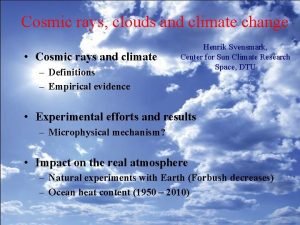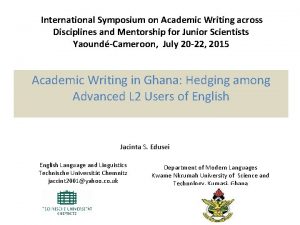Cosmic rays across scales and disciplines April 13

- Slides: 1

Cosmic rays across scales and disciplines April 13, 2018 EGU 2018 -9500 Cosmic rays and their interaction with astrospheres Andrei Sadovski, Alexey Struminsky, Maria Zharikova Space Research Institute (IKI), Moscow, Russian Federation (asadovsk@iki. rssi. ru) GCR. Grießmeier et al. (2015) considered the dependence of the Galactic cosmic rays (GCR) induced radiation dose on the strength of the planetary magnetic field and its atmospheric depth. GCR modulation was not considered! Scherer et al. (2002) demonstrated by quantitative modeling that a change of the interstellar medium surrounding the heliosphere triggers significant changes of planetary environments caused by enhanced fluxes of neutral atoms as well as by the increased cosmic ray fluxes. Cohen et al. (2012) showed that the GCR flux near the Archean Earth (for the early Sun) would has greatly reduced than is the case today is mainly due to the shorter solar rotation period and tighter winding of the Parker spiral. Sadovski et al. (2018) considered radiation conditions close to Proxima b. They should be determined by stellar CR since there are no GCR due to GCR modulation by the stellar wind. SCR Tabataba-Vakili et al. (2015) consirdered an influence of stellar cosmic rays (SCR) на on atmospheres of exoplanets assuming that their spectra are similar to spectra Solar CR at 1 AU with scaling of distance to exoplanets as a square of radius. Atri (2016) consirdered an influence of SCR using spectra of well known solar proton events - hard 23. 02. 1956 (SPE 56), soft - 4. 08. 1972 (SPE 72), medium -29. 09. 1989 (SPE 89). The GOAL – to estimate fluxes of GCR and SCR near exoplanets in a habitable zone of stars of different spectral classes using solar-stellar analogies and simple models elaborated for the Sun and the heliosphere at the beginning of space era – solar wind(Parker, 1958), GCR modulation(Parker, 1958), stellar CR (Hayakava, 1969). Stellar wind astrosphere Stellar Cosmic Rays Maximal possible temperature of the quite corona corresponds to the critical point at the photosphere. f. Np – proton production per second, f – frequency of stellar flares Other astrospheres Stellar wind and GCR modulation - Proxima Centauri ( TRAPPIST 1) Ø Rotation period 83 (3) days Ø average stellar magnetic field 600 G, no magnetic field maps Ø Wind velosity 450 -1200 (440 -1080) km/s Ø First turn of the Parer spiral 23 (1 -2) AU Ø Wind density 781 -4320 (600 -4562) см-3 Ø Radius of the astrosphere 168 -625 (157 -627) AU. PROXIMA b Trappist 1 d Trappist 1 f Ø GCR would be absent up to about 1 Te. V due to stellar wind modulation Proxima (TRAPPIST 1) Exreme Events sp. class O 5 B 0 B 5 A 0 A 5 F 0 F 5 G 0 G 5 K 0 K 5 M 0 M 5 M 8 L*/Ls M*/Ms R*/Rs 7. 9 E 5 5. 2 E 4 830 54 14 6. 5 3. 2 1. 5 0. 8 0. 4 0. 15 0. 08 0. 01 0. 001 60 16 7 3 2 1. 8 1. 5 1. 05 0. 92 0. 78 0. 69 0. 51 0. 2 0. 1 14 7. 4 3. 9 2. 4 1. 7 1. 5 1. 4 1. 1 0. 92 0. 85 0. 72 0. 6 0. 27 0. 11 H AU B 0 B G 746 710 185 693 26. 4 870 10. 6 925 3. 3 970 2. 1 1147 1. 6 1122 1. 1 1195 0. 73 1338 0. 64 1468 0. 38 1480 0. 24 1527 0. 08 2125 0. 02 3352 Emax/(αβ) Te. V 69 36 24 15 11 12 11 9 8. 5 8. 7 7. 4 6. 4 4. 0 0. 5 Tcor К 1. 733 e+07 8. 745 e+06 7. 260 e+06 5. 056 e+06 4. 758 e+06 4. 854 e+06 4. 334 e+06 3. 861 e+06 4. 045 e+06 3. 712 e+06 3. 876 e+06 3. 438 e+06 2. 996 e+06 3. 677 e+06 Lx Erg/s 4. 550 e+32 2. 193 e+31 6. 025 e+30 1. 045 e+30 5. 988 e+29 5. 662 e+29 3. 554 e+29 1. 864 e+29 1. 835 e+29 1. 255 e+29 1. 237 e+29 6. 775 e+28 1. 884 e+28 1. 571 e+28 V Km/s 4. 942 e+03 3. 216 e+03 2. 468 e+03 1. 933 e+03 1. 640 e+03 1. 562 e+03 1. 420 e+03 1. 306 e+03 1. 300 e+03 1. 209 e+03 1. 143 e+03 1. 009 e+03 8. 741 e+02 8. 453 e+02 n cm^-3 2. 900 e-03 8. 196 e-03 2. 409 e-01 5. 352 e-01 5. 089 e+00 1. 363 e+01 1. 946 e+01 2. 763 e+01 5. 187 e+01 6. 851 e+01 2. 224 e+02 4. 365 e+02 1. 645 e+03 2. 315 e+04 Mass rate g/s 4. 327 e+15 4. 895 e+14 2. 248 e+14 6. 309 e+13 4. 931 e+13 5. 093 e+13 3. 840 e+13 2. 370 e+13 2. 342 e+13 1. 840 e+13 1. 992 e+13 1. 377 e+13 4. 994 e+12 4. 248 e+12 R ast-sph AU 4. 815 e+04 1. 306 e+04 7. 755 e+03 3. 636 e+03 2. 961 e+03 2. 937 e+03 2. 432 e+03 1. 817 e+03 1. 553 e+03 1. 572 e+03 1. 227 e+03 6. 879 e+02 6. 239 e+02 Ø Stellar wind velocity and density estimates within the Parker model, radius of astrosphere for maximal coronal temperature. Ø Values of stellar wind velocity differ by several times but observed values of stellar magnetic field may differ by one-two orders in comparison with corresponding solar values. ØTo estimate GCR modulation in some point in the astrosphere we need know stellar magnetic field and rotation period, parameters of local interstellar medium Conclusions Ø Stellar and galactic cosmic rays (SCR and GCR) are important factors of space weather determining radiation conditions near e[oplanets. Ø GCR spectrum and its variations near exoplanets are detemined by modulation processes in astrospheres – stellar wind parameters and local conditions of the interstellar medium. Ø As a result of modulation GCR would be practically absent near exoplanets of stars with strong magnetic field. Radiation conditions would be determined by SCR – stellar activity, energy distribution of flares (frequency), orbit parameters of exoplanets.

